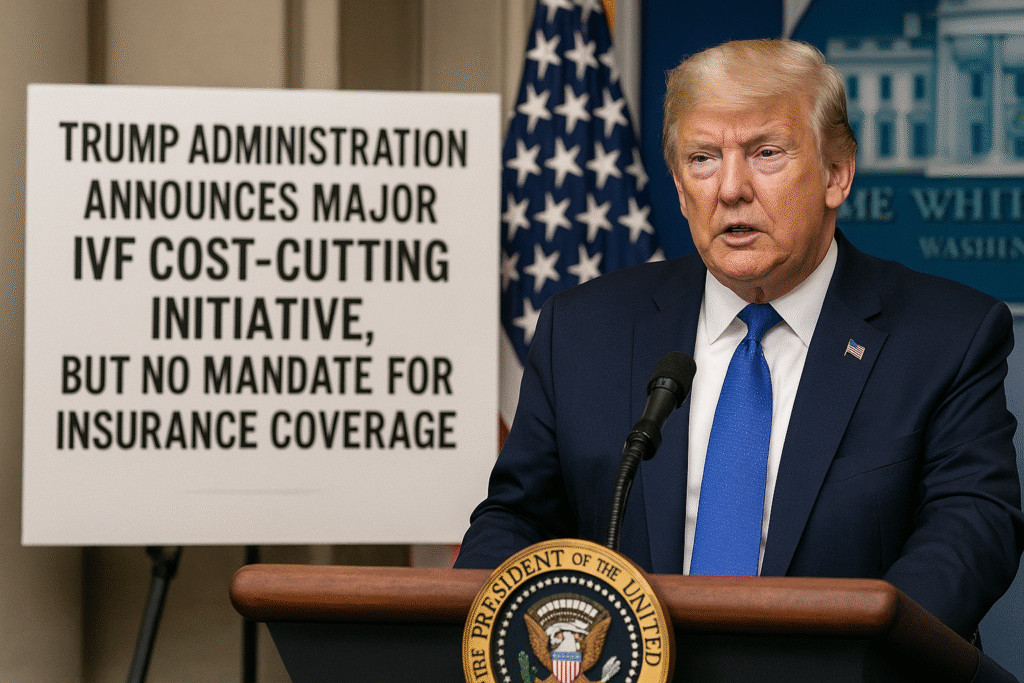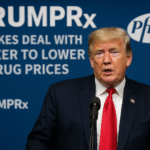By Harshit | October 17, 2025 | Washington, D.C. | 1:00 AM EDT
In a long-anticipated move, President Donald Trump on Thursday unveiled new measures aimed at making in vitro fertilization (IVF) treatments more affordable for American families. The announcement, delivered from the Oval Office, marks one of the administration’s most visible steps to address rising fertility treatment costs—but stops short of requiring insurers to cover IVF procedures.
White House Partners With Drugmaker to Slash Fertility Drug Prices
The administration said it has negotiated lower prices for one of the most widely used fertility drugs, Gonal-f, through a partnership with EMD Serono, a subsidiary of pharmaceutical giant Merck. The deal will make IVF medications available at up to an 84% discount through TrumpRx, a federal direct-to-consumer website expected to launch in early 2026.
Libby Horne, head of U.S. fertility operations at EMD Serono, confirmed the development, saying, “We are proud to announce that Americans will have access to our leading IVF therapies for an 84% discount off list prices.”
The drugmaker also stated that its products will be exempt from certain industry-specific tariffs, provided the company continues to invest in manufacturing and research within the United States. The agreement represents a broader effort by the Trump administration to stimulate domestic pharmaceutical production while reducing consumer drug costs.
No Insurance Mandate Yet, Despite Earlier Promises
While the announcement drew praise for its focus on affordability, it did not include a new rule mandating insurance coverage for IVF—a pledge the president had previously made. Instead, the administration said it would issue guidance from the Departments of Labor, Treasury, and Health and Human Services (HHS) to help employers offer fertility benefits outside traditional medical plans, similar to dental or vision insurance.
“We want to make it easier for all couples to have babies, raise children, and start the families they have always dreamed about,” Trump said during the briefing. He framed the effort as part of his broader commitment to “family growth, women’s health, and American prosperity.”
The proposed guidance would allow employers to purchase stand-alone fertility benefits through private providers, giving workers another avenue to access IVF assistance without requiring insurance carriers to alter existing health plans.
Widespread Out-of-Pocket Burden for IVF Patients
Currently, most Americans seeking IVF treatment face significant out-of-pocket expenses, often exceeding $15,000 per treatment cycle, according to data from KFF, a nonpartisan health policy research group. Only a limited number of states, such as Illinois, Massachusetts, and New York, require private insurers to cover IVF in some capacity.
The Trump administration’s plan could offer temporary financial relief, but health policy experts note that medication costs account for only part of overall IVF expenses. Patients also pay for medical procedures, lab testing, egg retrieval, and embryo transfer, costs that remain outside the scope of Thursday’s announcement.
Dr. Melissa Warren, a reproductive endocrinologist based in Chicago, welcomed the lower drug prices but urged the administration to address the broader cost structure. “Discounting medications is an important step,” she said, “but unless there’s comprehensive coverage or insurance support, IVF will remain out of reach for many middle-class families.”
Industry and Political Reaction
Pharmaceutical analysts have called the partnership with EMD Serono a strategic win for both the administration and the company. The initiative allows Merck’s U.S. arm to avoid new tariffs while expanding its domestic footprint—an alignment with the Trump administration’s “America First” manufacturing agenda.
Critics, however, argue that the announcement may serve more as a political gesture than a transformative healthcare policy. “Without an enforceable coverage mandate, the real barrier—high treatment costs—remains largely intact,” said Elaine Bristow, a healthcare economist at Georgetown University. “Drug discounts are helpful, but the procedural costs are what deter most families.”
Next Steps and Broader Implications
Administration officials said that more details on the multi-agency guidance will be released in the coming weeks. The White House also plans to meet with insurance companies, employers, and medical associations to explore voluntary benefit expansion programs by early 2026.
For now, the focus remains on driving down pharmaceutical costs while signaling continued attention to family-building issues—a theme Trump has emphasized throughout his presidency.
“America’s families deserve affordable access to the miracle of life,” Trump said in closing. “This is a first step, not the last.”







